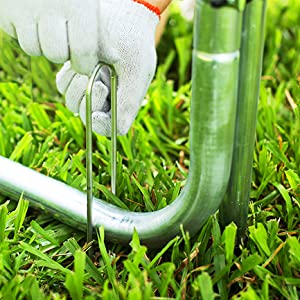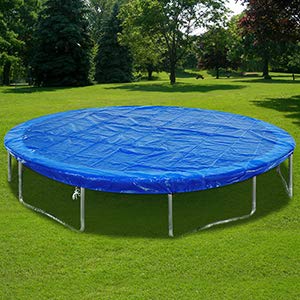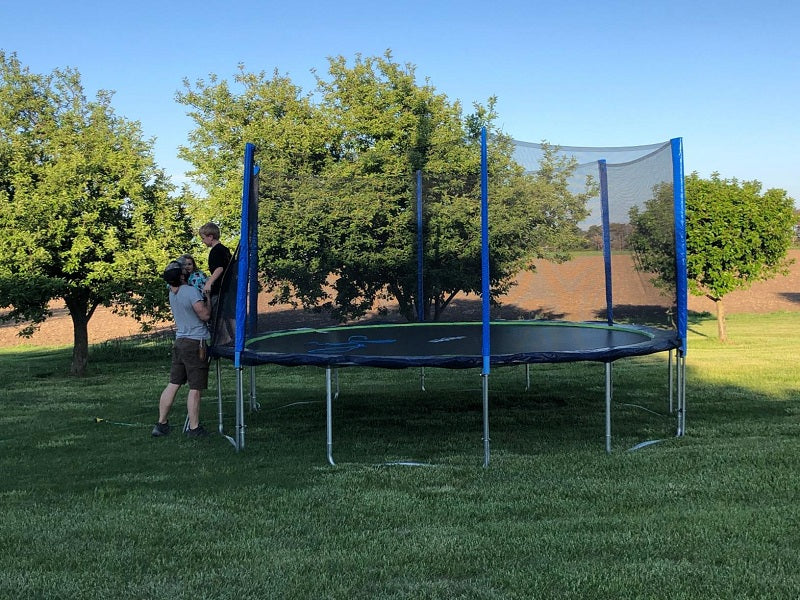As the kickoff of the holiday season, we know winter is around the corner. Recently, Zupapa Customer Happiness Executives are receiving more and more inquiries about trampoline winter care. We’re here to give answers to the following four frequently asked questions. Keep reading to find the best suitable care & maintenance method for you.
- Can I use the trampoline in winter?
- Should I disassemble the trampoline?
- What precautions should I take for trampoline winterization?
- What are the general steps to disassembly the trampoline?
Here comes the first question, “ Can I use the Zupapa trampoline in winter?” Theoretically, the answer is yes. The Zupapa trampoline is made of high-quality materials that are rust-resistant, which means you can leave it outdoors and use it in winter. But (Yes, there is always a big BUT) you should pay more attention to safety guidelines when using a trampoline in winter. Keep in mind: Kids should not be allowed to play without (with inadequate) supervision.
- Firstly, beware of the weather. Needless to say, bad weather is more often to expect in winter than in other seasons. If you’re the supervisor, never allow the kids to play when it’s rainy, windy, or (and) foggy. Playing in bad weather is the main cause of injuries.
- Even it’s a good day for playing, do not ignore any precautions. Carefully check to ensure the jumping area is clean and dry before each use. The padding and jumping mat are easier to get wet in winter, we highly recommend you, whether the supervisor or the jumper, to clean the jumping area each time.
- Sounds a bit weird but true: You’d better not wear too many bulky winter clothes or a scarf although it’s cold. Wear tight-fitting clothes that make jumping on the trampoline comfortable.
In terms of the disassembly, you should be the judge. Of course, the ultimate protection is to take down all parts, store them in a dry and clean place until the warm spring comes. That’s what we hope every owner can follow. However, it takes a lot of time and energy to (dis)assemble. So, if the trampoline is going to be used frequently, or if you do not have enough space to store all trampoline parts, you’d prefer to leave it outdoors.
Here naturally comes the third question,” What precautions should I take for trampoline winterization?” In a word, you should take precautions to protect against the snow and high winds when it comes to trampoline winterization.
Regular care for the ensure net, jumping area, and other accessories is the most practical method for winterization. When the weather is good, every-two-week-clean is enough. However, if it’s snowy, you’d better be ready to clean every hour in case of any snow stocking. The snow itself will not harm the trampoline, but the weight and the melted water would deteriorate the materials, making them less strong and more fragile. Another important tip when sweeping away snows on the jumping mat is not to use a shovel or blower(even a plastic one) because it can cause scratches or tear, then finally ruin the mat. A soft broom is the best choice. Also do not forget to wipe out the surface with a clean and dry cloth after sweeping away piled-up snows.
High winds are another big threat for trampolines in winter. Not any owner would like to see the trampoline fly up into the air as leaves with heavy wind gusts. Once it happens, besides the damages to the trampoline, it's also a great danger to people and property. So, take necessary precautions to anchor and strengthen your trampoline to the ground. Here are two cost-friendly ways:
Stakes. Zupapa provides lawn stakes for each trampoline. Ensure to anchor the trampoline properly to the ground with them. If you lost them, whether some or all, do not hesitate to contact us, our Customer Happiness Executives are glad to arrange for shipping as soon as possible.

Trenches. This precaution should be done before you assemble the trampoline. Dig trenches in the ground, place all support legs into them, and then pack dirt or other mulches around so that the frame is secured by the ground at the very beginning. This works as well as the stakes in most cases. However, you should note that the soil can be weakened by a lot of moisture, which would damage the buried legs oppositely.
If you leave the trampoline outdoors without the intention to use it, we recommend you partly disassemble it by removing the enclosure net and those support poles because it makes it easy out(in) when you need to clean the jumping mat and the foam padding.
In any situation, do not forget to put on the rain cover when the trampoline is not in use. It works great on protecting the frame and jumping area from UV damage and keeping debris, dust, and leaves out of the area underneath.

Before calling an end, we’d like to address the general steps to disassemble the trampoline. You can also refer to the Zupapa assembly instructions in reverse order for more details. Before disassembling, ensure there is nothing left on the jumping mat, padding, and the enclosure net. If the rain cover is put on, remove it first. Then you can:
- Take the foam poles and the enclosure net that is attached to the pole down. You’d better zip the net for easier use in the future;
- Take the jumping mat, padding, and springs down;
- Take all support accessories for the frame down.
Do not forget to check all parts to ensure you have them in dry condition with the right quantities before storing them.





